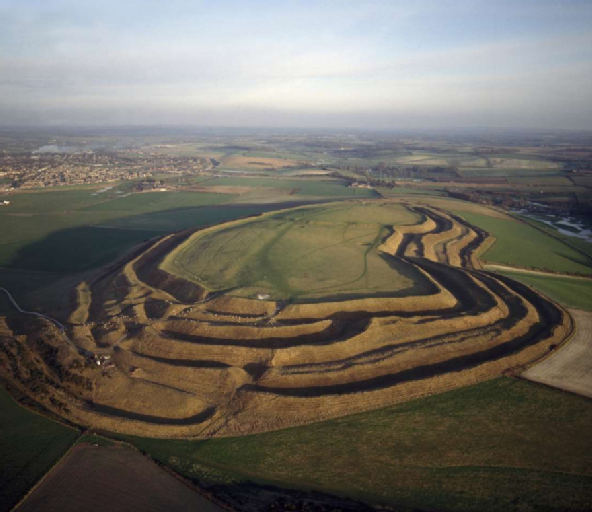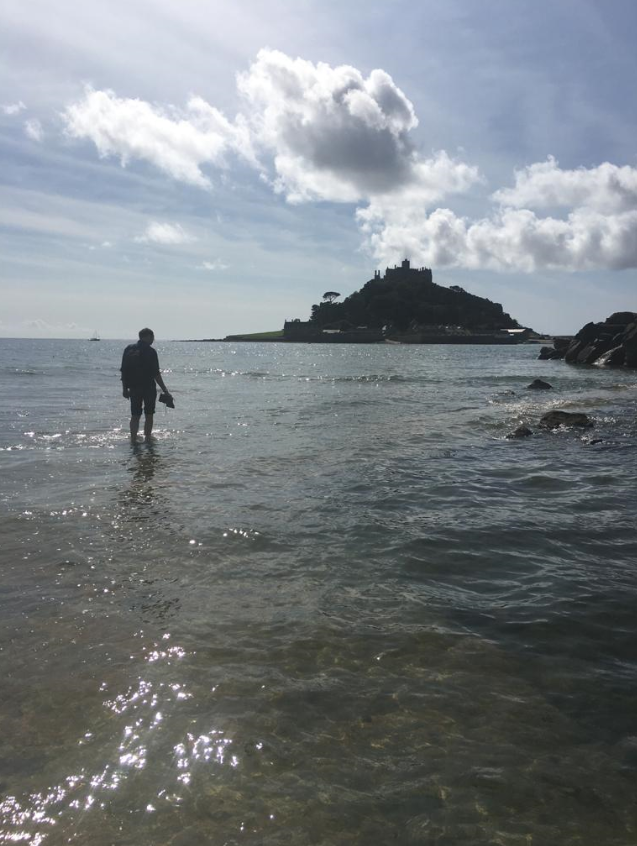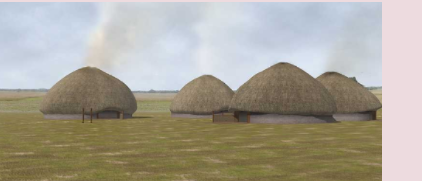Iron Age Britain

Introduction to the Iron Age
The Iron Age in Britain began around 750BC and lasted until the coming of the Romans in AD43.
It was the arrival of iron working techniques from southern Europe that brought Britain into the Iron Age. Iron was stronger and more plentiful than bronze and iron working revolutionised many aspects of life, most importantly agriculture. Iron tipped ploughs could turn soil more quickly and deeply than older wooden or bronze ones, and iron axes could clear forest land more efficiently for agriculture. There was a landscape of arable, pasture and managed woodland. There were many enclosed settlements and land ownership was important.
British Tribes and Hillforts
Hillforts were an important part of the Iron Age British landscape, especially in the west. An amazing website, the Oxford Atlas of Hillforts shows us just how many hillforts there were scattered across the countryside. Take a look and see where the nearest hillforts are to you, and then why not go and visit?
Iron Age Britons lived in organised tribal groups, ruled by a chieftain. These groups would have changed and evolved throughout the Iron Age, and their early interactions seem to have been hostile, perhaps as tribal groups and boundaries settled in to place. This inter-tribal warfare was traditionally interpreted as the reason for the building of hill forts, as defensive areas where small communities across the landscape could muster and stand their ground when attacked.
But while this may have been the case in some, some hillforts are sited on the sides of hills with poor defensive value, and so some may best be seen simply as communal gathering places or even strongholds of elites within the groups. Some may even have simply been enclosures for domesticated animals such as cows.
Although the first had been built about 1500 BC, hillfort building peaked during the later Iron Age. There are over 2,000 Iron Age hillforts known in Britain. By about 350 BC many hillforts went out of use and the remaining ones were reinforced. Why so many went out of use is not known. Perhaps people had begun to meet together as larger tribal groups in just a few of the most important hillforts. You can find out more about the tribes which had developed by the time of the arrival of the Romans here.
One of the most spectacular hillforts is that of Maiden Castle in Dorset. Check out the English Heritage Maiden Castle website for more details of its history, some of which I have adapted below.

Maiden Castle - a hillfort in Dorset
Maiden Castle is one of the largest and most complex Iron Age hillforts in Britain. Its vast multiple ramparts enclose an area the size of 50 football pitches, and the site was home to several hundred people in the Iron Age (800 BC–AD 43). Excavations during the 1930s and 1980s have unearthed much of its history, from its origins as a Neolithic enclosure over 6,000 years ago, its modifications during the Iron Age, to the construction of a Romano-British temple here.
The hill was originally inhabited during the Neolithic period when as enclosure was built here on the hill top following the clearing of the woodland on top. Following a period of reduced activity, the first hillfort was constructed in the early Iron Age. Enclosed by a single rampart, it was built on top of the earlier enclosure and was later extended west to enclose more than double the original area. Extra ramparts were added, the inner rampart was heightened and the entrances became increasingly complex as more ramparts were added and gateways were redesigned.
The same sort of changes must have happened at other hillfort sites as well. Many would have been built where previous settlements had been found and would have become more complex during the Iron Age. This is particularly true for the first few hundred years, because generally - and this is true also of Maiden Castle - in the later Iron Age defences seem to have become less important. As stated already, hill forts more genrally seem to have been less used in this later period, so it seems that the reasons for their occupation changed considerably as the Iron Age progressed.
At the height of its occupation, the Maiden Castle fort was densely populated and there were many roundhouses. These had central hearths, large pits for storing grain and were often circled by drainage gullies. Various finds from the site show that activities such as textile production and metalworking were taking place here.
In the middle Iron Age, the layout of the interior of the hillfort was reorganised. Once randomly arranged houses were now built in regimented rows, with traffic guided along roads. This reorganisation suggests some control existed over social life within the fort.
Later in the Iron Age, this organised system broke down, and the focus of the settlement became once again the eastern end of the hillfort. At this time, there was increasing trade with the continent, and specialised industries such as metal-working were becoming very important.
Pytheas - a Greek in Iron Age Britain
We know of a traveller named Pytheas, a Greek colonist from Massalia (modern day Marseille in southern France) who wrote an account of his voyages by sea - the Periplus - around Britain and Ireland and even up to the Arctic. The name of his book, Periplus, is Greek for 'sailing around'. Unfortunately his book is lost, but enough ancient authors themselves quoted passages of his book or referred back to it, so we know something of what he saw. He is thought to have lived around in the latter part of the fourth century BC, the time when Alexander the Great lived and was travelling in the opposite direction into Asia.
Pytheas called the Iron Age Britons the "Pretanoi", which is linguistically linked with "Britanni", and was quoted as writing that the Britons were renowned wheat farmers. Large farmsteads produced food in industrial quantities and Roman sources note that Britain exported hunting dogs, animal skins and slaves. Then there was tin. His account of the tin trade in perhaps Cornwall was used by the historian Diodorus Siculus in this account from Book, Chapter 22 of his Library of History:
The inhabitants of that part of Britain which is called Belerion are very fond of strangers and from their interactions with foreign merchants are civilized in their manner of life. They prepare the tin, working very carefully the earth in which it is produced. The ground is rocky but it contains earthy veins, the produce of which is ground down, smelted and purified. They beat the metal into masses shaped like knuckle-bones and carry it off to a certain island off Britain called Ictis. During the ebb of the tide the intervening space is left dry and they carry over to the island the tin in abundance in their wagons ... Here then the merchants buy the tin from the natives and carry it over to Gaul, and after travelling overland for about thirty days, they finally bring their loads on horses to the mouth of the Rhone.
Some people believe that St Michael's Mount in Cornwall (below) is the location of this island Ictis.

Dr Grigsby walking to St Michael's Mount as the tide comes in and covers the causeway.
What is interesting is that Pytheas' use of the name Pretanoi may reflect the name that all or certain Britons called themselves. This is not always the case (for example the Greeks called themselves Hellenes and it was the Romans who invented that other more familar name). As the archaeologist and author Barry Cunliffe summarises:
"It is quite probable that the description of Britain given by the Greek writer Diodorus Siculus in the first century BC derives wholly or largely from Pytheas. What is of particular interest is that he calls the island "Pretannia" (Greek "Prettanikē"), that is "the island of the Pretani, or Priteni". "Pretani" is a Celtic word that probably means "the painted ones" or "the tattooed folk", referring to body decoration - a reminder of Caesar's observations of woad-painted barbarians. In all probability the word "Pretani" is an ethnonym (the name by which the people knew themselves), but it remains an outside possibility that it was their continental neighbours who described them thus to the Greek explorers."
- Barry Cunliffe, Britain Begins, Oxford University Press, 2021, p.4.
Iron Age Settlement in Coventry

Researchers at the University of Warwick have discovered late Iron Age roundhouses on the university campus. The discovery of the outline of 15 late iron age roundhouses on the University of Warwick's campus is hugely significant for Coventry, being the earliest evidence of settlement within the modern boundary of the city. More information can be found here.
